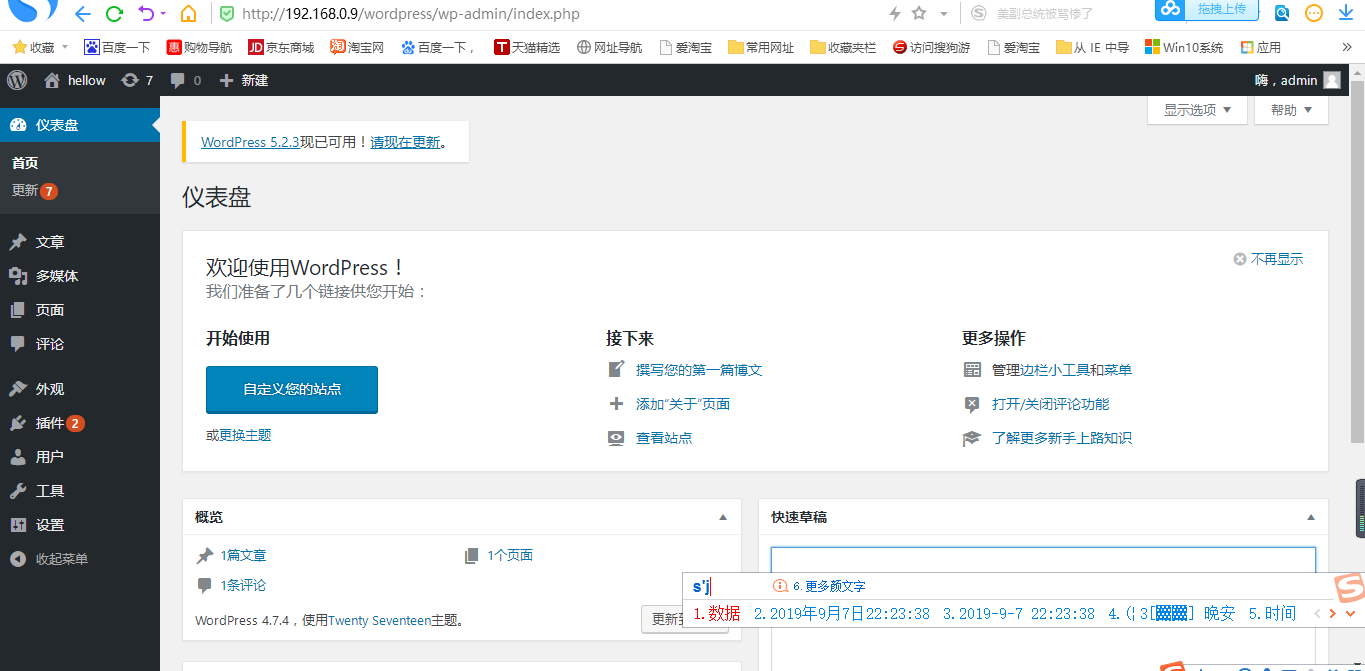Anibler + shell script builds wordpress Forum
ansible, as an automated operation and maintenance tool, has many functional modules, which can be better deployed with shell scripts.
Environmental Science:
192
192.168.0.11 #ansible
ansible configuration
[root@localhost ansible]# egrep "^[^#]" /etc/ansible/hosts
[lnmp]
192.168.0.9
Software version:
nginx 1.81
mysql 5.5 (yum installation)
php 7.31
wordpress 4.7
ansible yaml file code:
- hosts: lnmp remote_user: root tasks: - name: "create install directory" file: path: /opt/lnmp state: directory - name: "copy nginx_tar.gz" copy: src: /opt/lnmp/nginx-1.8.1.tar.gz dest: /opt/lnmp - name: "start install nginx" script: /opt/lnmp/nginx_install.sh - name: "remove mariadb" yum: name=mariadb,mariadb-server state=absent - name: "install mariadb" yum: name=mariadb,mariadb-server state=latest - name: "Adding fields to my.cnf" script: /opt/lnmp/mysql_admin.sh - name: "restart mysql" service: name=mariadb state=restarted - name: "create test databases" command: mysql -uroot -p123123 -e "drop database wordpress;create database wordpress;grant all privileges on wordpress.* to 'root'@'192.168.0.9' identified by '123123';flush privileges;" - name: "copy php tgz" copy: src: /opt/lnmp/php-7.3.1.tar.gz dest: /opt/lnmp - name: "script php install bash" script: /opt/lnmp/php_install.sh - name: "copy php-fpm.conf" template: src: /opt/lnmp/php_conf/php-fpm.conf dest: /usr/local/php7/etc/ - name: "copy php.ini" template: src: /opt/lnmp/php_conf/php.ini dest: /usr/local/php7/ - name: "copy wwww.conf" copy: src: /opt/lnmp/php_conf/www.conf dest: /usr/local/php7/etc/php-fpm.d/ - name: "start php" script: /opt/lnmp/php_restart.sh - name: "wordpress.tar.gz copy" unarchive: src: /opt/lnmp/wordpress-4.7.4-zh_CN.tar.gz dest: /var/www/php mode: 0777 owner: nobody group: nfsnobody
nginx_install.sh code
#!/bin/bash
##this is nginx install bash
nginx_tar=/opt/lnmp/nginx*.gz
ng_path=/opt/lnmp
if [ -e $nginx_tar ];then
tar zxvf $nginx_tar -C $ng_path
else
echo "nginx.tar.gz does not exist"
fi
#yum
yum install -y gcc gcc-c++ autoconf gd-devel automake zlib zlib-devel openssl openssl-devel pcre*
if [ ! $? -eq 0 ];then
echo "error yum install"
exit 1
fi
sleep 5
#configure
cd /opt/lnmp/nginx*
./configure \
--prefix=/usr/local/nginx \
--user=nginx \
--group=nginx \
--with-http_ssl_module \
--with-http_gzip_static_module \
--with-http_image_filter_module \
--with-http_stub_status_module
if [ $? -eq 0 ];then
make && make install
fi
#create nginx user
id nginx
if [ ! $? -eq 0 ];then
useradd -M -s /sbin/nologin nginx
else
userdel -r nginx
useradd -M -s /sbin/nologin nginx
fi
#Modify configuration files
nginx_conf_path=/usr/local/nginx/conf/nginx.conf
cat >${nginx_conf_path} <<EOF
worker_processes auto;
events {
worker_connections 1024;
}
http {
include mime.types;
default_type application/octet-stream;
sendfile on;
keepalive_timeout 65;
server {
listen 80;
server_name localhost;
location / {
root /var/www/php;
index index.html index.htm index.php;
}
error_page 500 502 503 504 /50x.html;
location = /50x.html {
root html;
}
location ~ \.php$ {
root /var/www/php;
fastcgi_pass 127.0.0.1:9000;
fastcgi_index index.php;
fastcgi_param SCRIPT_FILENAME \$document_root\$fastcgi_script_name;
include fastcgi_params;
}
}
}
EOF
#create root document
www_path=/var/www/php
if [ ! -d "$wwww_path" ];then
mkdir -p ${www_path}
fi
#create test index html
echo "this is nginx test html" > ${www_path}/test.html
#check nginx pid
nginx_pid=`pgrep nginx | wc -l`
if [ $nginx_pid -eq 0 ];then
/usr/local/nginx/sbin/nginx
echo "nginx has started...."
else
killall nginx
/usr/local/nginx/sbin/nginx
echo "nginx has restart..."
fiphp_install.sh code
#!/bin/bash ##PHP install script #Tar php.tgz php_tar=/opt/lnmp/php*.gz configure_path=/opt/lnmp if [ -e $php_tar ];then tar zxvf $php_tar -C $configure_path else echo "php*.tar.gz does not exist...." exit 1 fi #create php user id php if [ ! $? -eq 0 ];then useradd -M -s /sbin/nologin php else userdel -r php useradd -M -s /sbin/nologin php fi #yum yum install libxml2 libxml2-devel -y #configure cd /opt/lnmp/php* ./configure \ --prefix=/usr/local/php7 \ --with-pdo-mysql=/opt/mysql \ --enable-mysqlnd \ --with-pdo-mysql=mysqlnd \ -with-mysqli=mysqlnd \ --with-mysql-sock=/tmp/mysql.sock \ --with-config-file-path=/usr/local/php7 \ --enable-fpm \ --with-jpeg-dir \ --with-png-dir \ --with-zlib-dir \ --with-gd #make install if [ ! $? -eq 0 ];then echo "make install error,please check configure" else make && make install fi
php_restart.sh code
#!/bin/bash php_pid=`pgrep php-fpm | wc -l` if [ $php_pid -eq 0 ];then /usr/local/php7/sbin/php-fpm else killall php-fpm /usr/local/php7/sbin/php-fpm fi
mysql_admin.sh code
#!/bin/bash
sed -ri "1a skip-grant-tables" /etc/my.cnf
systemctl restart mariadb
sleep 3
mysql -uroot -e "use mysql;update user set password=password('123123') where user='root'; flush privileges;"
sed -ri "2d" /etc/my.cnfAccess after installation http://192.168.0.9/wordpress/wp-admin Configure wordpress
After filling in the database username password (if the database host is not good, use IP address), the installation is completed. The following is the login interface.
